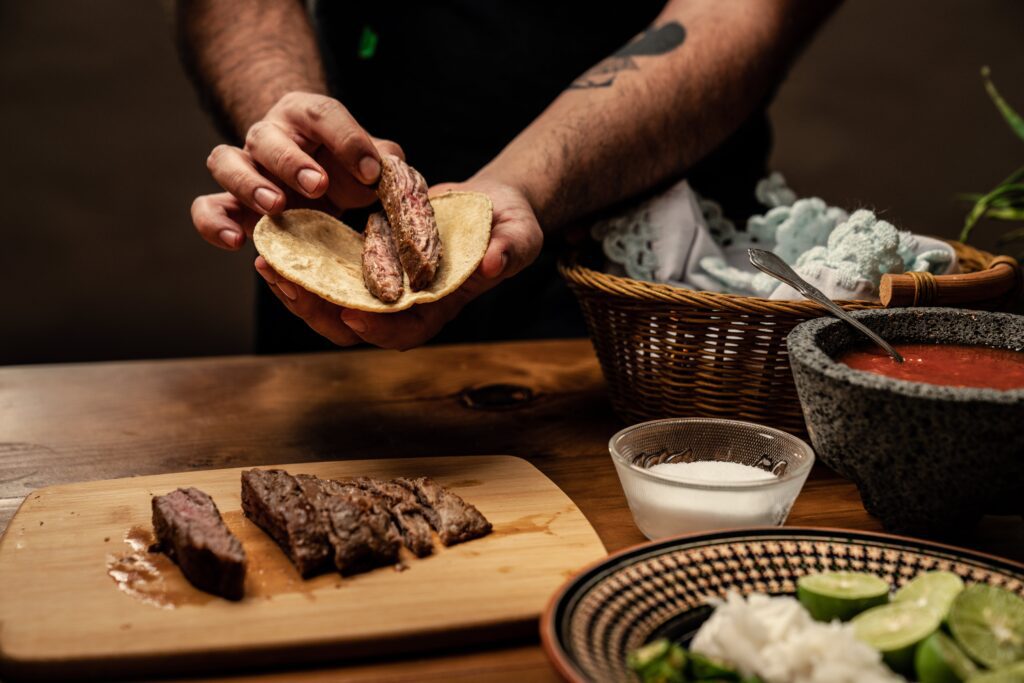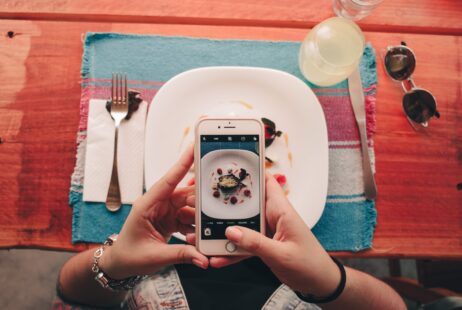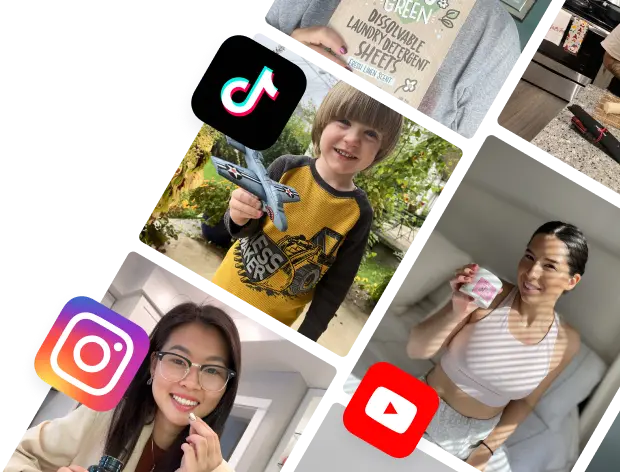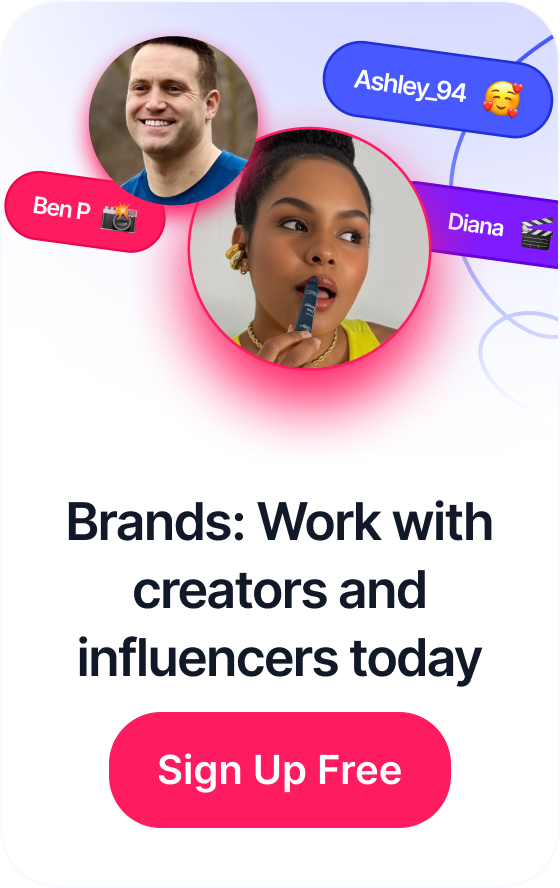 Find Influencers on TikTok – A-Z Guide, Criteria, Precautions, Pros, FAQs
Find Influencers on TikTok – A-Z Guide, Criteria, Precautions, Pros, FAQs
Foodie influencing is a trend where individuals share their culinary experiences, preferences, and recipes on various platforms. With millions of users, it signifies a thriving community. Brand owners can partner with foodie influencers to offer a direct route to engage with a target audience, showcasing products through authentic and relatable gastronomic content.
With JoinBrands, you can connect with authentic foodie influencers to promote your restaurant or products. With the help of these foodie influencers, you can drive brand growth and foster authentic connections with your target audience.
This article guides us through finding foodie influencers using JoinBrands in 6 steps as well as 5 other methods. After that, you also get a 5 step foodie influencer marketing guide. It highlights 8 key traits of a good foodie influencer, outlines 5 precautions when collaborating, and discusses 5 benefits of such partnerships. FAQs and a conclusion offer additional insights.
Now we will answer: How to Find a Foodie Influencer.

Table of Contents
What is a Foodie Influencer?
Foodie Influencers are social media personalities who specialize in creating and sharing appealing culinary content. These influencers curate delightful gastronomic experiences, emphasizing creativity and relatability. Common types include Recipe Creators, Restaurant Critics, and Health-Conscious Foodies, etc. These influencers elevate brand promotion by offering authentic endorsements, engaging audiences with delicious narratives, enhancing credibility, expanding reach, and fostering consumer loyalty.
Here are the diverse types of Foodie Influencers that can help your brand grow:
- Recipe Creators: Experts in crafting and sharing unique recipes, ideal for brands in the food and cooking industry seeking engaging content.
- Restaurant Critics: Provide reviews and recommendations, suitable for restaurant owners or food-related businesses looking to enhance their online presence.
- Health-Conscious Foodies: Focus on nutritious and wholesome choices, catering to brands promoting healthy and mindful eating experiences.
Now, we will discuss how to find these types of Foodie Influencers, including the best method with JoinBrands, along with other effective approaches.
6 Methods to Find Foodie Influencers
In this section, we will discuss some of the other methods to find foodie influencers. We will include the overview, tools used and step by step procedure so you can promote your brand or sell products effectively through influencer marketing.
Let’s review 6 methods in detail.
Method 1: Finding Foodie Influencers with JoinBrands (Best & Most Recommended)
JoinBrands allows you to connect authentically with Foodie influencers for your brand. This platform allows brands to customize their foodie influencer search based on various criteria, including content type, influencer demographics, and product details.
Here are the 6 steps to find foodie Influencers using JoinBrands:
- Sign Up on JoinBrands: Register as a brand.
- Start a Campaign: Choose ‘UGC Videos: Content Only’ for foodie videos.
- Add Product Information: Include details like type, name, price, industry, and an external link, along with an image.
- Choose Delivery Option: Decide between reimbursement or direct delivery to foodie influencers.
- Customize Creator Demographics: Select specific foodie influencer demographics like gender, age, and ethnicity.
- Review and Create Your Campaign: Finalize your choices and launch the campaign.
The significance of this method lies in its customization capabilities, enabling brand owners to precisely target the types of foodie influencers that align best with their brand’s image and audience.
In order to have a step by step (image based guide) to find foodie influencers on JoinBrands, click here.
Now we will look at the next item on the list, finding foodie influencers on other influencer marketing platforms.
Method 2: Keyword Search on YouTube
Perform a targeted keyword search on YouTube using terms related to your brand or niche. This helps identify Foodie Influencers who create content aligning with your product or service.
Here are the 3 steps to find Foodie Influencers using this method:
- Enter relevant keywords in the YouTube search bar.
- Explore video results and filter by foodie influencers producing food-related content.
- Assess video engagement, comments, and subscriber count.
This method ensures direct visibility into YouTube content that resonates with your brand, enhancing the potential for meaningful collaborations with Foodie Influencers. Now, let’s delve into the next method.
Method 3: YouTube Analytics and Insights
Analyze YouTube metrics and insights to identify Foodie Influencers whose content aligns with your brand’s target audience and goals.
Here are the 3 steps to find Foodie Influencers using this method:
- Access YouTube Analytics for data on views, engagement, and audience demographics.
- Identify foodie influencers with a significant and engaged subscriber base.
- Assess content relevance to your brand’s niche.
Utilizing YouTube Analytics provides data-driven insights, allowing brand owners to make informed decisions and choose Foodie Influencers with a genuine impact on their target audience. Now, let’s explore the next method on the list.
Method 4: Collaboration Platforms for Foodie Influencers
Engage with specialized collaboration platforms that connect brands with Foodie Influencers for mutually beneficial partnerships.
Here are the 3 steps to find Foodie Influencers using this method:
- Join reputable collaboration platforms like JoinBrands, specifically designed for influencer marketing.
- Browse through Foodie Influencer profiles and portfolios.
- Use platform features to filter foodie influencers based on audience demographics and engagement metrics.
Collaboration platforms streamline the influencer discovery process, offering a curated pool of Foodie Influencers open to partnerships. This approach ensures efficient and targeted outreach to potential collaborators.
Method 5: Social Media Monitoring
Monitor social media platforms, especially Instagram and Twitter, to identify emerging Foodie Influencers with growing influence.
Here are the 3 steps to find Foodie Influencers using this method:
- Leverage social media monitoring tools to track trending hashtags related to food and influencers.
- Identify foodie influencers generating buzz with popular posts and engagements.
- Evaluate content authenticity and audience engagement.
Social media monitoring allows brand owners to stay ahead of trends and discover rising Foodie Influencers before they reach mainstream attention.
Method 6: Influencer Marketing Agencies
Collaborate with influencer marketing agencies specializing in the food and culinary niche for expert guidance in connecting with Foodie Influencers.
Here are the 3 steps to find Foodie Influencers using this method:
- Research and identify influencer marketing agencies with expertise in food-related campaigns.
- Consult with agencies to understand their network of Foodie Influencers.
- Provide campaign goals and preferences for personalized foodie influencer recommendations.
Influencer marketing agencies offer strategic insights and industry knowledge, simplifying the process of finding and collaborating with Foodie Influencers aligned with your brand objectives.
The Complete Foodie Influencer Marketing Guide (5 Easy Steps)
To find the right Foodie Influencer, start by identifying your target audience and defining campaign objectives. Research foodie influencers on platforms like Instagram, TikTok, or YouTube, focusing on authenticity and engagement. Evaluate influencers based on genuine connections and analyze metrics. Establish relationships through personalized outreach, fostering collaborations. Now, understanding the influencer marketing process, let’s delve into what makes a Foodie Influencer effective.
1. Identify Your Target Audience
To find the right Foodie Influencer for your brand, start by identifying your target audience. Understand the demographics, interests, and preferences of your potential customers through market research or existing data. For instance, if you run a gourmet bakery, your target audience might be young urban professionals interested in artisanal pastries.
2. Define Your Campaign Objectives
Next, define your campaign objectives clearly. Outline the goals of your influencer marketing campaign and align them with your broader marketing strategies and brand identity. These objectives could range from increasing brand awareness to driving product sales or promoting a new menu item.
3. Research Relevant Foodie Influencers
Once your objectives are set, research relevant Foodie Influencers. Explore platforms like Instagram, TikTok, or YouTube, and use hashtags and keywords related to your niche to identify potential collaborators. Look for foodie influencers who share a passion for gastronomy and culinary experiences.
4. Evaluate Authenticity and Engagement
It’s crucial to evaluate the authenticity and engagement of potential foodie influencers. Scrutinize foodie influencers for genuine connections with their audience and analyze engagement metrics such as likes, comments, and shares. Choose foodie influencers whose content resonates with their followers, ensuring authenticity in their endorsements.
5. Establish Relationships with Foodie Influencers
Finally, reach out and establish relationships with selected foodie influencers. Craft personalized outreach messages expressing genuine interest and clearly communicate campaign details, expectations, and benefits. Building relationships, such as offering exclusive tastings or collaborations, is essential to successful partnerships with Foodie Influencers.
Now that we know how an influencer marketing campaign for a platform like Instagram works, we will explore what makes a good Foodie Influencer.
What makes a Good Foodie Influencer? (8 Things to Consider to Find the Right Foodie Influencer)
To identify an effective foodie influencer, consider authenticity, engagement rate, niche alignment, visual appeal, audience demographics, consistent brand values, communication skills, and adaptability. Authenticity builds trust, engagement rate indicates audience connection, and niche alignment ensures relevance. Visual appeal captivates audiences, demographics target the right market, while consistent values and communication skills enhance credibility. Adaptability ensures an influencer remains relevant in dynamic trends.
1. Authenticity
Authenticity is the foodie influencer’s genuine passion and connection with the food they promote, instilling trust among followers. It’s crucial because audiences seek real experiences, and an authentic foodie influencer can build stronger connections. For example, a brand promoting healthy snacks would benefit from a foodie influencer who authentically shares their health journey. In contrast, an inauthentic foodie influencer might endorse products unrelated to their lifestyle, creating a disconnect.
2. Engagement Rate
Engagement rate measures the interaction a foodie influencer receives relative to their follower count, indicating the depth of connection with the audience. A higher engagement rate is important because it signifies an active and dedicated audience. Consider a food brand partnering with a foodie influencer with a 5% engagement rate, ensuring that their content resonates deeply. In contrast, a lower engagement rate might indicate disinterest or fake followers, diminishing the campaign’s impact.
3. Niche Alignment
Niche alignment ensures the foodie influencer’s content closely aligns with a specific food category, enhancing relevance. It’s essential because a well-defined niche attracts a more targeted and interested audience. For instance, a brand specializing in vegan products collaborates with a foodie influencer dedicated to plant-based recipes. Conversely, a foodie influencer with broad, unfocused content may not effectively cater to a niche audience, diluting the brand’s message.
4. Visual Appeal
Visual appeal refers to the attractiveness and quality of the foodie influencer’s content, crucial for capturing audience attention. It’s vital because compelling visuals enhance the overall impact of the content. Imagine a dessert brand partnering with a foodie influencer known for stunning, mouth-watering food photography—enticing visuals elevate the brand’s products. On the contrary, a foodie influencer with low-quality visuals might fail to showcase the product’s allure effectively, impacting consumer perception.
5. Audience Demographics
Understanding the foodie influencer’s audience demographics ensures alignment with the brand’s target market. It’s essential for tailoring campaigns to resonate with specific consumer groups. For example, a brand targeting young professionals should collaborate with a foodie influencer whose audience predominantly comprises this demographic. On the flip side, partnering with a foodie influencer whose audience doesn’t align with the brand’s target market may result in ineffective promotions.
6. Consistent Brand Values
Consistent brand values indicate shared principles between the foodie influencer and the brand, fostering an authentic connection. It’s crucial because aligning values enhances the foodie influencer’s ability to authentically promote the brand. Consider a sustainable food brand collaborating with a foodie influencer who actively promotes eco-friendly practices. In contrast, a foodie influencer endorsing products conflicting with the brand’s values may undermine credibility and authenticity.
7. Communication Skills
Communication skills reflect the foodie influencer’s ability to convey messages effectively and engage their audience. This is vital as clear and engaging communication enhances the impact of brand promotions. For instance, a brand launching a new product benefits from collaborating with a foodie influencer who can articulate its features and benefits eloquently. Conversely, a foodie influencer with poor communication skills may struggle to effectively convey the brand’s message, impacting campaign effectiveness.
8. Adaptability
Adaptability gauges a foodie influencer’s ability to evolve with changing trends and preferences, ensuring sustained relevance. It’s crucial because the digital landscape and consumer preferences are dynamic. A foodie influencer who consistently adapts can offer fresh and appealing content. Consider a brand aiming to stay on-trend collaborating with a foodie influencer quick to adopt new food trends. On the other hand, an influencer resistant to change may lose relevance, impacting the brand’s campaign success.

5 Things to Take Care of While Working with Foodie Influencers (Necessary Precautions)
To ensure successful collaborations with foodie influencers, prioritize authenticity verification, analyze audience alignment, establish clear contracts, provide content guidelines, and monitor engagement metrics. Authenticity safeguards brand credibility, audience analysis prevents mismatches, contractual clarity avoids disputes, guidelines maintain brand values, and metric monitoring optimizes campaign performance. These precautions collectively contribute to effective and trustworthy influencer partnerships in the food industry.
1. Authenticity Verification
Ensure the authenticity of foodie influencers by examining their past content and audience engagement to guarantee that their expressed passion for food aligns genuinely with their audience’s interests. This is crucial to prevent misrepresentation, as partnering with foodie influencers who mislead about their culinary interests could harm your brand’s credibility. Authenticity builds trust, and misrepresentation can lead to a loss of consumer trust in the brand. Failing to verify authenticity may result in collaborations with foodie influencers who misrepresent their love for food, causing harm to the brand’s credibility. A food brand collaborates with a foodie influencer who falsely claims expertise in gourmet cuisine, damaging the brand’s reputation when exposed.
2. Audience Analysis
Conduct a thorough analysis of the foodie influencer’s audience to ensure alignment with your target market. This safeguards against mismatched content and outreach. An aligned audience ensures effective brand resonance, preventing the dissemination of content that may not appeal to the intended consumer base. Misaligned audiences can lead to ineffective campaigns, resulting in missed opportunities to connect with the desired consumer demographic. A healthy snack brand collaborates with a foodie influencer whose audience primarily follows content related to indulgent treats, diminishing the campaign’s impact.
3. Contractual Clarity
Clearly define collaboration terms in contracts to avoid misunderstandings, ensuring that both parties understand expectations. Clear contracts prevent potential conflicts and misunderstandings, providing a framework for successful collaborations. Ambiguous terms can lead to disputes, harming relationships and potentially damaging the brand’s reputation. A brand collaborates with a foodie influencer, but disagreements arise due to unclear contract terms, causing reputational damage.
4. Content Guidelines
Establish clear content guidelines for foodie influencers to adhere to, maintaining the brand image and preventing associations with potentially harmful content. Guidelines ensure consistency and prevent foodie influencers from creating content that goes against the brand’s values. Lack of guidelines may result in foodie influencers producing content inconsistent with the brand’s image, leading to reputational damage. An eco-friendly brand collaborates with a foodie influencer who creates content promoting excessive waste, causing reputational harm.
5. Monitoring Metrics
Regularly monitor engagement metrics to assess campaign performance and make data-driven decisions. Metrics provide insights into campaign effectiveness, helping optimize strategies for better results. Failing to track metrics may result in missed opportunities for improvement and campaign optimization. A foodie influencer campaign lacks metric monitoring, making it challenging to identify areas for improvement and optimize future strategies.
5 Benefits of Working with Foodie Influencers (Why Should You Even Partner?)
Partnering with a foodie influencer offers benefits such as authentic audience connections, increased product visibility, sales growth, enhanced brand recognition, and targeted audience reach. Imagine the power of a genuine connection translating to a 10% engagement rate and a 30% increase in product visibility, leading to significant sales growth and heightened brand recognition, all while precisely reaching your target audience.
1. Authentic Connection with Audience
Building an authentic connection with a foodie influencer requires aligning brand values with the influencer’s content. A 10% engagement rate on a sponsored post could mean connecting with 50,000 engaged customers, translating to increased brand loyalty and trust.
2. Increased Product Visibility
Boosting product visibility through a foodie influencer involves strategic collaboration for maximum exposure. Imagine a 30% increase in product visibility, leading to potentially 300,000 impressions per post, significantly expanding your brand’s reach and market presence.
3. Sales Growth
Collaborating with a foodie influencer often translates into tangible sales growth. A 20% increase in sales attributed to the foodie influencer’s promotion can mean a substantial revenue boost, turning followers into actual customers and contributing to the overall business growth.
4. Brand Recognition
Aligning your brand with a popular foodie influencer enhances brand recognition. Consider a 25% increase in brand recognition resulting from the collaboration, indicating heightened awareness and recall among potential customers, contributing to a stronger brand identity.
5. Targeted Audience Reach
Leveraging a foodie influencer’s niche ensures reaching a targeted audience. Picture a 15% increase in reaching your specific target market, ensuring that your brand message resonates with those most likely to convert into customers, leading to more effective marketing strategies.
Frequently Asked Questions (FAQs)
Let’s answer the most frequently asked questions about finding foodie influencers for your brand.
How can I find foodie influencers for my brand?
You can find foodie influencers for your brand through Join Brands. JoinBrands simplifies your search by providing a user-friendly platform where you can connect with foodie influencers, offering a streamlined process to find and collaborate with influencers tailored to your brand’s needs.
What criteria should I consider when selecting a foodie influencer?
The criteria you should consider when selecting a foodie influencers includes engagement rates, niche relevance, and audience authenticity. This ensures a genuine connection that resonates with your brand and guarantees optimal ROI.
How do I determine if a foodie influencer is the right fit for my brand?
You can determine if a foodie influencer is the right fit for your brand by assessing the influencer’s content quality, engagement metrics, and audience demographics. Leverage tools like JoinBrands to analyze data and make informed decisions for a seamless collaboration.
How can I ensure a successful partnership with a foodie influencer?
You can ensure a successful partnership with a foodie influencer by clearly communicating expectations, outlining deliverables, and establishing a mutually beneficial relationship. Regularly track performance metrics and optimize strategies to maximize the impact of your collaboration.
What benefits can I expect from partnering with foodie influencers?
Benefits you can expect from partnering with foodie influencers include increased brand visibility, authentic audience connections, enhanced product visibility, targeted reach, and heightened brand recognition, resulting in substantial growth and engagement metrics for your business.
Conclusion
In conclusion, navigating the realm of foodie influencers is made more accessible with tools like JoinBrands. By emphasizing criteria like engagement rates, niche relevance, and audience authenticity, brands can strategically align themselves with influencers who resonate genuinely. Clear communication, performance tracking, and optimization further ensure a successful collaboration, bringing forth the myriad benefits of heightened brand visibility, authentic connections, and increased recognition. The key lies in leveraging the right resources to forge impactful partnerships in the ever-expanding world of foodie influencers.








